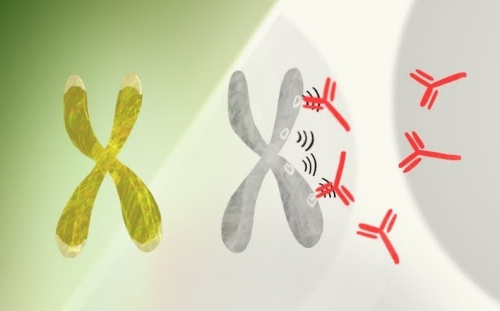by Serena Crawford, Yale University Superimposed structures of the SRA domain bound to DNA double helix (orange) from the 3CLZ.pdb, modeled CMFT bound SRA (yellow) and methylated cytosine (green). Credit: Journal of Biological Chemistry (2024). DOI: 10.1016/j.jbc.2024.107443In a new study, Yale researchers identified a molecule that binds to a disease-associated macrophage migration inhibitory factor (MIF)...
Tag: <span>Autoimmune</span>
Research team identifies target protein regulating autoimmune disease lupus
by Pohang University of Science and Technology Schematic of the mechanism of action of ETV5 on TFH cell differentiation. Credit: POSTECHA research team including Professor Yoontae Lee and Jiho Park, a Ph.D. candidate, from the Department of Life Sciences at Pohang University of Science and Technology (POSTECH) has discovered that a particular protein promotes the...
‘Double life’ of key immune protein reveals new strategies for treating cancer and autoimmune diseases
by NYU Langone Health Credit: CC0 Public DomainInsights into the workings of an immune cell surface receptor, called PD-1, reveal how treatments that restrict its action can potentially be strengthened to improve their anticancer effect, a new study shows. The same findings also support experimental treatment strategies for autoimmune diseases, in which the immune system...
Small study adds to growing hope CAR-T cell therapy could revolutionize autoimmune disease treatment
By Theresa Gaffney ADOBEPeople with autoimmune disorders don’t usually get to talk about a cure. There’s symptom management, hopeful periods of remission often followed by relapses, but rarely a lasting fix for the way their immune system attacks healthy cells. If the immune system is an army, then those with conditions like lupus, multiple sclerosis, or...
Stanford Medicine-led study shows why women are at greater risk of autoimmune disease
Research throws light on the mystery of why women are much more prone to autoimmune disorders: A molecule made by one X chromosome in every female cell can generate antibodies to a woman’s own tissues. By Bruce Goldman X chromosomes and autoimmunityIn every cell in a woman’s body, one X chromosome is disabled to ensure...
CAR T-Cell Therapy: A Cure for Systemic Autoimmune Diseases?
SAN DIEGO — CD19-directed chimeric antigen receptor (CAR) T-cell therapy, which has transformed the treatment landscape for B-cell malignancies, is now showing great promise in at least three distinct autoantibody-dependent autoimmune diseases. A single infusion of autologous CD19-directed CAR T-cell therapy led to persistent, drug-free remission in 15 patients with life-threatening systemic lupus erythematosus, idiopathic...
Autoimmune patients in CAR-T study see striking improvements across lupus and other diseases
Autoimmune patients in CAR-T study see striking improvements across lupus and other diseasesLei Lei WuNews ReporterSAN DIEGO — All of the first 15 autoimmune disease patients who received CAR-T therapy at a German hospital saw the debilitating symptoms of their diseases, including lupus and myositis, substantially improve or go away entirely, according to new research...
Lipid Nanoparticles That Deliver mRNA to T Cells Hold Promise for Autoimmune Diseases
Autoimmune disorders are among the most prevalent chronic diseases across the globe, affecting approximately 5-7% of the world’s population. Emerging treatments for autoimmune disorders focus on “adoptive cell therapies,” or those using cells from a patient’s own body to achieve immunosuppression. These therapeutic cells are recognized by the patient’s body as ‘self,’ therefore limiting side...
New lipidic peptide IK14004 shows promise in treating cancer and reducing autoimmune complications
By Dr. Liji Thomas, MDNov 15 2023Reviewed by Lily Ramsey, LLM A recent study published in Nature’s Scientific Reports described a lipidic peptide, named IK14004, which fosters the growth of immunosuppressive T regulatory (Treg) cells and separates interleukin-2 production from interferon-gamma, while also activating CD8+ T cells. Study: An immunomodulating peptide with potential to suppress...
Macrophages that rapidly digest dying B cells may point to future autoimmune disorder treatments
by Weizmann Institute of Science TBMs (green) swallow dying B cells (red) inside the lymph node “training camps.” Credit: Weizmann Institute of Science Parents tell their children to eat all the food on their plate, down to the last crumb. Certain cells within our lymph nodes, like obedient children, diligently follow this instruction. Although these cells—a...





